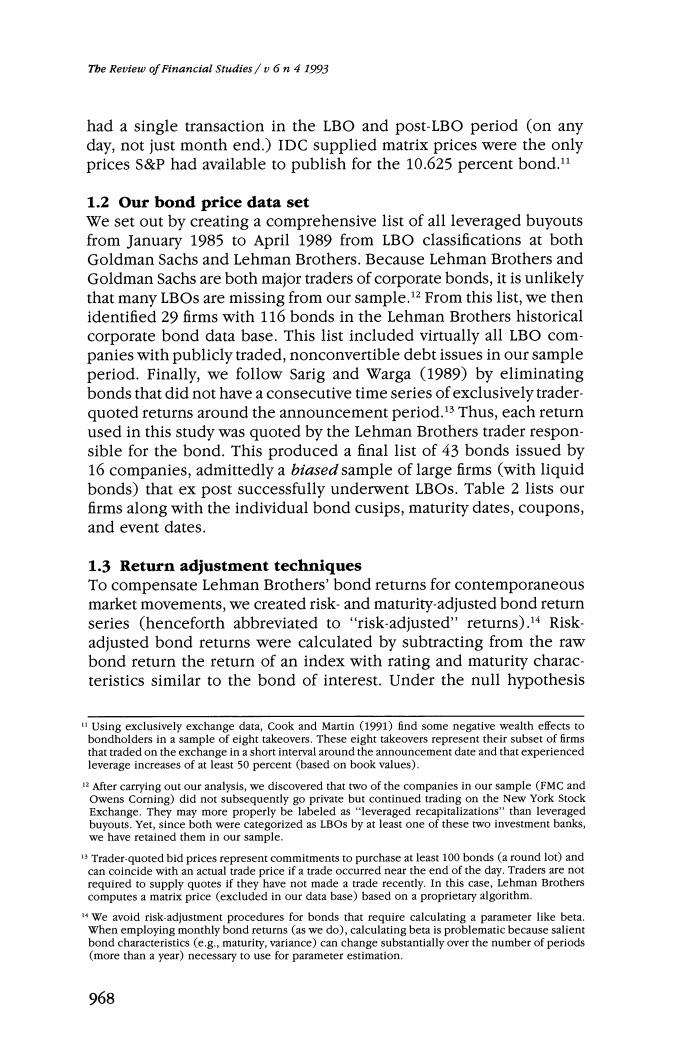正在加载图片...

The Review of Financial Studies/v 6 n 4 1993 had a single transaction in the LBO and post-LBO period (on any day,not just month end.)IDC supplied matrix prices were the only prices S&P had available to publish for the 10.625 percent bond. 1.2 Our bond price data set We set out by creating a comprehensive list of all leveraged buyouts from January 1985 to April 1989 from LBO classifications at both Goldman Sachs and Lehman Brothers.Because Lehman Brothers and Goldman Sachs are both major traders of corporate bonds,it is unlikely that many LBOs are missing from our sample.12 From this list,we then identified 29 firms with 116 bonds in the Lehman Brothers historical corporate bond data base.This list included virtually all LBO com- panies with publicly traded,nonconvertible debt issues in our sample period.Finally,we follow Sarig and Warga (1989)by eliminating bonds that did not have a consecutive time series of exclusively trader- quoted returns around the announcement period.'3 Thus,each return used in this study was quoted by the Lehman Brothers trader respon- sible for the bond.This produced a final list of 43 bonds issued by 16 companies,admittedly a biased sample of large firms (with liquid bonds)that ex post successfully underwent LBOs.Table 2 lists our firms along with the individual bond cusips,maturity dates,coupons, and event dates. 1.3 Return adjustment techniques To compensate Lehman Brothers'bond returns for contemporaneous market movements,we created risk-and maturity-adjusted bond return series (henceforth abbreviated to "risk-adjusted"returns).14 Risk- adjusted bond returns were calculated by subtracting from the raw bond return the return of an index with rating and maturity charac- teristics similar to the bond of interest.Under the null hypothesis Using exclusively exchange data,Cook and Martin (1991)find some negative wealth effects to bondholders in a sample of eight takeovers.These eight takeovers represent their subset of firms that traded on the exchange in a short interval around the announcement date and that experienced leverage increases of at least 50 percent (based on book values). After carrying out our analysis,we discovered that two of the companies in our sample (FMC and Owens Corning)did not subsequently go private but continued trading on the New York Stock Exchange.They may more properly be labeled as"leveraged recapitalizations"than leveraged buyouts.Yet,since both were categorized as LBOs by at least one of these two investment banks, we have retained them in our sample. Trader-quoted bid prices represent commitments to purchase at least 100 bonds (a round lot)and can coincide with an actual trade price if a trade occurred near the end of the day.Traders are not required to supply quotes if they have not made a trade recently.In this case,Lehman Brothers computes a matrix price (excluded in our data base)based on a proprietary algorithm. We avoid risk-adjustment procedures for bonds that require calculating a parameter like beta. When employing monthly bond returns (as we do),calculating beta is problematic because salient bond characteristics (e.g.,maturity,variance)can change substantially over the number of periods (more than a year)necessary to use for parameter estimation. 968